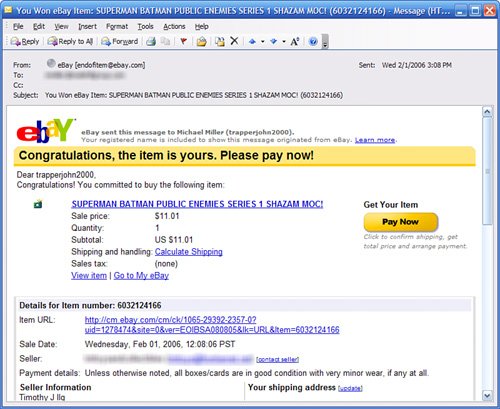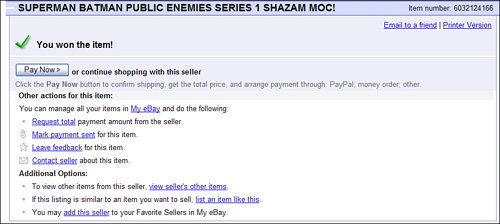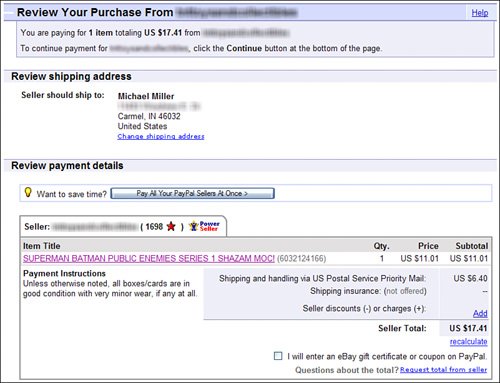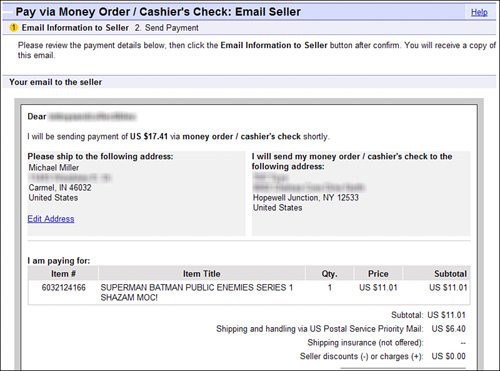Paying for Your Item
| How can you pay for your auction item? As you recall from Chapter 8, "Bidding in Online Auctions," most sellers specify which payment methods they accept in their auction listings. Once you've won an auction, you can choose which of these methods of payment you want to use. Tip
Paying by Credit Cardvia PayPalPaying via credit card is the preferred method for most buyers. Assuming that you pay your credit card bill in full when it arrives, there are no fees involved. Unlike with money orders or cashier's checks, you don't have to leave home to arrange payment. You also have an excellent paper trail for your payment; you know almost immediately if the seller has received payment. And, unlike personal checks, credit cards ensure faster shipment; as soon as you authorize payment, the buyer receives his funds and can ship the item to you. Tip
Unfortunately, most private individuals don't have the capability to accept credit card paymentand most sellers on eBay happen to be individuals. Many small businesses sell items on eBay, however, and most of these firms do accept payment by credit card. There is, however, a way for an individual seller to accept credit card payments: by using PayPal. PayPal is an online payment service (owned by eBay) that serves as the middleman for these transactions; you pay PayPal via credit card, and PayPal handles all the credit card paperwork and sends a check to the seller (or deposits funds in the seller's checking account). From your standpoint as a buyer, using PayPal is transparentyou don't even have to pay any additional fees (outside of your normal credit card fees, of course). You make your payment via credit card the same way you would as if you were shopping at any large online merchant. So if you see a PayPal logo in the item listing (like the one in Figure 10.1), you're in luck; that means you can use your credit card to pay, if you win. Figure 10.1. Look for the PayPal logo at the bottom of an auction listing. If the seller accepts PayPal payments, your end-of-auction notification will look like the one in Figure 10.2. This same Pay Now button also appears in the closed auction listing page on eBay, as shown in Figure 10.3. You can pay from either the end-of-auction email or the auction listing pageor, if you're already registered with PayPal, you can pay directly from the PayPal website. Figure 10.2. Pay directly from eBay's end-of-auction notification email... Figure 10.3. ...or pay from the closed auction listing page. When you click the Pay Now button, you're transferred to a Review Your Purchase page, like the one shown in Figure 10.4. Make sure that all the transaction details are correct, and then scroll to the bottom of the page, select a payment method, and click the Continue button. Figure 10.4. Choose how you want to pay. If you select to pay via PayPal, you're now taken to a PayPal payment page. Follow the onscreen instructions to make your payment. You can also pay for an eBay auction directly from the PayPal website (www.paypal.com). Just make sure you know the seller's eBay ID or email address, the number and title of the auction, and the total amount you owe (including shipping and handling). From the PayPal main page, click the Send Money tab to display the Send Money page. Follow the instructions there to enter the seller's email address and necessary auction information. Note
Of course, PayPal isn't just for credit card payments. You can make PayPal payments from your debit card, via a checking account withdrawal, or via withdrawal of standing funds in your PayPal account. Just choose the payment method you prefer, when prompted. Other Payment MethodsIf the seller doesn't accept PayPal payments, or if you want to pay via another method, you should check one of the non-PayPal payment methods at the bottom of the Review Your Purchase page. When you click the Continue button, you see the Email Seller page shown in Figure 10.5. Make sure that all the information here is correct, and then click the Email Information to Seller button. Figure 10.5. Sending your payment information to the seller. If you're paying by personal check, now is the time to write the check and put it in the mail. If you're paying by cashier's check or money order, head to the bank or post office, cut a payment, and then put it in the mail. Remember to include your name and shipping address, along with the item number and description, with your payment. (Or just include a printout of the Send Information to the Seller email that eBay sent to you.) Tip
Paying by CheckEven though most buyers today pay via credit card (thanks to PayPal), payment by personal check remains popular. It's pretty easy for you as a buyer to pull out your checkbook, write a check, and put it in the mail. That said, not all sellers today accept personal checks. In addition, paying by check will probably slow down your item's shipment. That's because savvy sellers will hold items paid for by a personal check for one to two weeks, until the check clears your bank. Other sellers will look at a buyer's feedback rating, and if it's strong, they'll go ahead and ship the merchandise when they receive the check. But don't expect a seller to ship immediately if you pay by personal check, especially if he hasn't dealt with you before or you're a relatively new eBay user.And don't be surprised if a seller doesn't accept personal checks; always check the seller's preferred payment methods before you place your bid. Paying by Money Order or Cashier's CheckSome sellers state that they prefer cashier's checks or money orders, and try to discourage payment by personal check. This is understandable; to the seller, cashier's checks and money orders are just like cash, but a personal check isn't good until it clears the bank. To you, the buyer, there are two potential downsides to paying via money order or cashier's check. First, it's a hassle; you have to go to the bank or post office or credit union, wait in line, fill out a form, and then arrange funding. Depending on your local conditions, that could be a time-consuming process. Second, depending on where you get your money orders, there may be a fee involved. The U.S. Postal Service, for example, charges $0.90 to cut a money order. Your bank may charge less (or moreor, in rare instances, nothing), but it's one more fee to add to what you're paying for the auction item. If you won a relatively low-priced item, the charge might not be worth it. Tip
Paying by CashNothing could be simpler than paying by cash. Cram some greenbacks and a few coins into an envelope, stick a stamp on it, and you're done. Right? Wrong. Paying by cash is definitely the least recommended method of payment. In fact, eBay discourages payment via cash, and for good reason. First, it's hard to hide cash in an envelope. Even if you wrap the bills in several sheets of paper and use a double envelope, there's something about a wad of cash that draws attention. Second, cash is easy to steal. Some disreputable types might see a cash-laden envelope sitting in a mailbox and make a grab for it. Easy to do. Third, there's nothing to track. If the seller says he never received your payment, there's nothing to trace to prove otherwise. (That's why cash is the preferred method of payment for illegal drug dealersit's virtually untraceable.) So, unless the auction item is priced absurdly low (so low you don't care if the money gets ripped off), you should probably avoid paying by cash. Using EscrowA final payment option, used primarily in higher-priced auctions, is the use of an escrow service. This is a company that acts as a neutral third party between the buyer (you) and the seller, holding your money until you receive the seller's merchandise. If you don't get the goods (or the goods are unacceptable), you get your money back; the seller gets paid only when you're happy. Note
Here's how a typical escrow transaction works:
Although you can use any third-party escrow service, eBay recommends Escrow.com (www.escrow.com). Go there for further information and instructions. Evaluating Different Methods of PaymentsNow you know how you can pay; you still want to know how you should pay. Which Method Is Fastest?When it comes to speed, paying by credit card (typically via PayPal) wins hands down. The seller receives his funds a few seconds after you click the Send button on the payment page, which means that shipment can occur almost immediately. Paying by personal check is definitely the slowest method. Not only do you have to wait for the postal service to deliver your check to the seller, but you also have to wait for the seller to waitfor your check to clear your bank. All this waiting means that the seller probably won't be able to ship your item for at least two weeks after the end of the auction, and maybe longer. Coming somewhere in the middle are money orders and cashier's checks. You still have to depend on snail-mail delivery of your payment, but when the seller receives it, he can ship your item immediately. Depending on the speed of the mail, figure anywhere from two days to a week before your item is shipped. Which Method Is Safest?Of course, how you pay for an item can increase or decrease your protection during a transaction; some methods of payment are safer for you than others. The least safe method of payment for a buyer is cash; there's nothing to track, and it's very easy for someone to steal an envelope full of cash. Also considered less safe (although considerably safer than sending cash) are cashier's checks and money orders; like cash, they provide no money trail to trace if you want to track down the seller. Paying by check gives you a minor trail to trace, but when the check is cashed, it's still pretty much a done deal. A much safer way to pay is by credit card. When you pay by credit card, you can always go to the credit card company and dispute your charges if the item you bought never arrived or was misrepresented. The same safety measures typically apply to credit card payments made through PayPal and other bill pay servicesalthough you should check with the bill pay service, just to be sure. "Mike Sez"
For the ultimate protection when buying an expensive item in a person-to-person option, use an escrow service. Because the escrow service acts as a neutral third party between you and the seller, if you don't receive what you wonor are otherwise dissatisfied with the itemyou get your money back, guaranteed. Which Method Should You Use?Use Table 10.1 to determine how you want to pay, based on several key conditions.
|
EAN: 2147483647
Pages: 204


